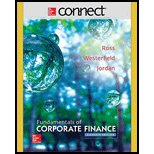
Concept explainers
Issues in Capital Budgeting [LO1] The debate regarding CFLs versus incandescent bulbs (see Problems 25–27) has even more wrinkles. In no particular order:
1. Incandescent bulbs generate a lot more heat than CFLs.
2. CFL prices will probably decline relative to incandescent bulbs.
3. CFLs unavoidably contain small amounts of mercury, a significant environmental hazard, and special precautions must be taken in disposing of burned-out units (and also in cleaning up a broken lamp). Currently, there is no agreed-upon way to recycle a CFL. Incandescent bulbs pose no disposal/breakage hazards.
4. Depending on a light’s location (or the number of lights), there can be a nontrivial cost to change bulbs (i.e., labor cost in a business).
5. Coal-fired power generation accounts for a substantial portion of the mercury emissions in the U.S., though the emissions will drop sharply in the relatively near future.
6. Power generation accounts for a substantial portion of CO2 emissions in the U.S.
7. CFLs are more energy and material intensive to manufacture. On-site mercury contamination and worker safety are issues.
8. If you install a CFL in a permanent lighting fixture in a building, you will probably move long before the CFL burns out.
9. Another lighting technology based on light-emitting diodes (LEDs) exists and is improving. LEDs are currently much more expensive than CFLs, but costs are coming down. LEDs last much longer than CFLs and use even less power. Plus, LEDs don’t contain mercury.
Qualitatively, how do these issues affect your position in the CFL versus incandescent lightbulb debate? Some countries have banned incandescent bulbs. Does your analysis suggest such a move is wise? Are there other regulations short of an outright ban that make sense to you?
Want to see the full answer?
Check out a sample textbook solution
Chapter 10 Solutions
Connect 1 Semester Access Card for Fundamentals of Corporate Finance
- Describe some different types of ratios and how they are used to assess performance. Explain the components of the formula and the order of operations to calculate them. Discuss what these ratios say about the financial health of the organization. Determine why it is sometimes misleading to compare a company's financial ratios with those of other firms that operate within the same industry.arrow_forwardIs there retained earning statement an important financial statement at the income statement and or the cash flows statement?arrow_forward2-13. (Term structure of interest rates) You want to invest your savings of $20,000 in government securities for the next 2 years. Currently, you can invest either in a secu- rity that pays interest of 8% per year for the next 2 years or in a security that matures in 1 year but pays only 6% interest. If you make the latter choice, you would then reinvest your savings at the end of the first year for another year. Why might you choose to make the investment in the 1-year security that pays an interest rate of only 6%, as opposed to investing in the 2-year security pay- ing 8%? Provide numerical support for your answer. Which theory of term structure have you supported in your answer? 2-14. (Yield curve) If yields on Treasury securities were currently as follows: TERM YIELD 6 months 1.0% 1 year 1.7% 2 years 2.1% 3 years 2.4% 4 years 2.7% 5 years 2.9% 10 years 3.5% 15 years 3.9% 20 years 4.0% 30 years 4.1% a. Plot the yield curve. b. Explain this yield curve using the unbiased…arrow_forward
- What is the holistic case study format, could you please provide an example?arrow_forwardDescription Discuss in detail the Goal(s) of the firm. Additionally, List and discuss the 5 principles that form the foundations of finance. Lastly, List and discuss the various legal forms of business organizations.arrow_forwardWhat is the purpose of a case studty? Why is it important for researchers? Please give the examplesarrow_forward
- Investors in corporate zero-coupon bonds include all of the following EXCEPT: A: Tax-exempt retirement plans B: Conservative investors who want to lock-in their returns C: Investors who are saving for their children's college education D: Investors who do not need current cash flows E: All of the above are potential zero-coupon investorsarrow_forwardWhat are some of Airbnb Legal Issues? How have Airbnb Resolved these Legal issues?WHat happened in the legal problem with Airbnb and Italy?arrow_forwardWhat are AIrbnb's Legal Foundations? What are Airbnb's Business Ethics? What are Airbnb's Corporate Social Responsibility?arrow_forward
- Discuss in detail the differences between the Primary Markets versus the Secondary Markets, The Money Market versus the Capital Market AND the Spot Market versus the Futures Market. Additionally, discuss the various Interest Rate Determinants listed in your textbook (such as default-risk premium.....).arrow_forwardHow can the book value still serve as a useful metric for investors despite the dominance of market value?arrow_forwardHow do you think companies can practically ensure that stakeholder interests are genuinely considered, while still prioritizing the financial goal of maximizing shareholder equity? Do you think there’s a way to measure and track this balance effectively?arrow_forward
